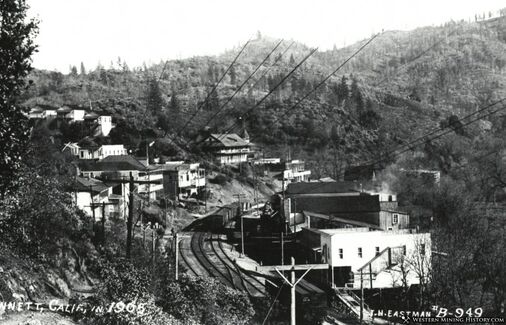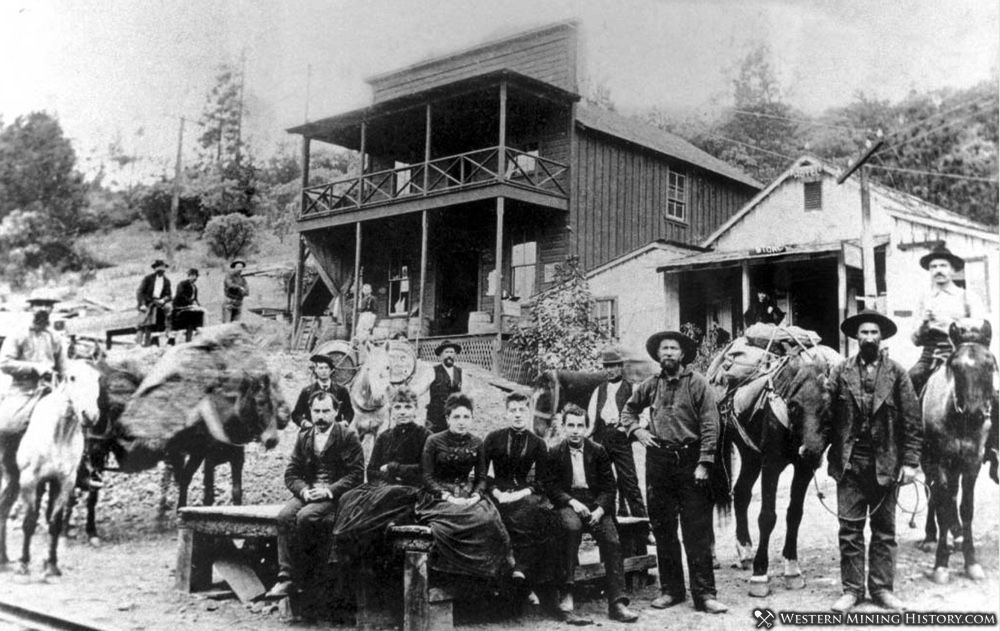 The remote community of Kennett in northern California in 1905. Some local newspapers referred to the town as “Kennet.” The remote community of Kennett in northern California in 1905. Some local newspapers referred to the town as “Kennet.” This is the third in a series of blog posts about my great-great uncle Richard T. Board, the uncle of my already infamous grandfather William Lyons Board. (Read Part I and Part II.) Many thanks again to my friend Tessa Bishop Hoggard for discovering yet another curiously dissipated ancestor of mine. It is only because of her extensive research that I am able to share these startling stories with you. As Richard Board approaches 40, perhaps he takes stock of his various schemes to find his fortune. As a young man, he evidently abandons a steady position as the deputy clerk to his father in his hometown of Harrodsburg, Ky.—or is run off for his repeated petty thefts and frauds. In 1885, when President Grover Cleveland appoints him to a federal position with the National Railway Service despite his criminal history, he steals a money order during his first trip aboard the train in New Mexico. Arriving in California sometime after serving two years in a federal prison in Illinois, he takes up with the former nurse to a soon-to-be-heiress. When no king’s ransom comes her way, he resorts to sending teenage boys into local stores to defraud proprietors. But that gets him a year in San Quentin. So what’s next? What might catch the attention of our aging antihero in California in 1899? Gold. By 1900, Richard and Mary have settled in Shasta County in northern California, near the town of Redding, with their son, approaching five years of age. The couple welcomes another baby about that time, a girl. They’re living in a cabin in the remote mining community of Kennett, where Richard is a partner in a gold mine. But it’s not long before he finds more trouble. Parties had evidently wrangled over who owned the Clipper Mine, and the courts had ruled in favor of one Alfonso di Nola over W. V. Huntington, from whom Board leased a portion of the mine. A fellow named Ross Spencer sub-leased from Board. On Monday, November 12, 1900, Spencer accompanies the newly certified owner, Alfonso di Nola, to the mine. Board appears from the mine with a gun and threatens to kill Spencer. Spencer and the three other men overpower Board and take his gun. Two days later Spencer swears out a warrant on Board for assault with a deadly weapon with intent to kill, a felony. Board is arrested the next day. Simultaneously, Board is served a second warrant for a misdemeanor: passing a fraudulent $30 check at the Golden Eagle Hotel with no funds in the Bank of California to cover it. Bonds of $500 for the felony and $50 for the misdemeanor are somehow paid—or dismissed, with the help of Board’s attorneys—and Board is released from custody. On November 19 Board pleads not guilty to the misdemeanor, and the case is eventually settled out of court. On December 13 the felony charge is referred to the Superior Court. On January 4, 1901, the same Redding newspaper that has been meticulously covering the criminal charges against Board reports in the “Town and County” section that “R. T. Board, lessee of the famous Clipper mine near Kennett, spent New Year’s in this city.” Richard T. Board Jr. has once again found his way from the police blotter to the society pages. Late that same New Year’s Day, a monstrous snowstorm descends upon northern California. One hundred miles north of Redding, the town of Yreka reported 63 inches of snow had accumulated by January 3, where “snow drifts were 6-7 feet in town, and businesses came to a halt so everyone could shovel snow off the businesses and keep their roofs from collapsing.” Rather than returning home to Kennett to check on his family as the storm settles in, Board chooses to travel on to San Francisco to meet with the owners of the Clipper mine. A week later, on Monday, January 7, Mr. Robert Hart—who had been part of the group accosted by Board in November and whose life it was rumored Board had threatened even before that incident—takes another man to Kennett to check on the Board family, “thinking the heavy snow might have caused them to be in distressed circumstances.” [The Searchlight (Redding, Calif.), January 8, 1901. All subsequent citations are to this newspaper unless otherwise noted.] They discover the Board cabin has been crushed under the weight of the snow. The tableau inside is horrific. On January 17, 1901, The Feather River Bulletin (Quincy, Calif.) runs the following headline: “Five Days the Baby Lived While Starvation and Gangrene Sapped Life.” The article included this report from the Free Press: Mrs. Board was killed by a falling of the roof. She had perhaps doubted if it would hold up under the great weight of snow. She may have been in fear for hours, and had drawn on a pair of overalls as if to be ready to flee the cabin if necessary. She had gone to the buggy where her baby lay. A key carried in her hand she thrust between her teeth that she might use both hands to lift the baby. As the mother bent over, a corner of the roof gave way and the timbers fell upon her, crushing her across the baby buggy. Her throat fell across the wicker side and she was strangled to death. The lad was not hurt by the falling roof. Tracks around the cabin showed where he had crawled out and run about, probably shouting, only to be mocked by the solitude. At last weakened by starvation he had lain down by his mother's upright dead body and exposure soon brought about his death. The child in its perambulator was shielded from the cold blasts. It could not freeze, but slowly it starved. The mother's body pressed the child's abdomen and circulation in the lower half of the body had ceased. Though the child was alive after five days, when discovered Monday, its tiny feet had turned black and gangrene was reaching upward toward the knees. The little one lived only a few hours after being released. Removing the bodies is not an easy task. “It was found necessary to make an improvised sled from one of the doors of the house and upon it the bodies were drawn to Kennet over the deep snow.” (January 8)
As word spread of the tragedy, the newspapers speculate about Richard Board’s whereabouts. His horse had been found at Kennett, probably at the train station where he had embarked first to Redding and then to San Francisco. Not being able to ascertain where he was during the storm, reporters don’t hesitate to admonish him for having abandoned his family in a time of peril. He is accused of longtime negligence. Three days later he is sighted in Redding. “Thursday evening R. T. Board passed through Redding on the northbound California express en route to Kennet, from where no one knows…Early Friday morning [he] started for the Clipper mine.” (January 11) When he arrives at Kennett, he finds his family’s coffins on the platform at the station. Arrangements had been made by Mary’s sister, Mrs. Martha Beadle Gowans, to transport the bodies for burial near her home in Sonoma County. Richard has a week to come up with a story. On Saturday, January 19, he returns to Redding to make a statement to the newspaper. He tells a convoluted tale of having asked a friend to check on his family as the snowstorm arrived and he departed for San Francisco, and of three men ordering him out of Kennett when he arrived to find his family’s remains at the train station. The newspaper immediately counters its recent accusations of negligence with a rather fantastic tale based on Board’s personal report. The next day, the headline offers this new narrative: “R. T. Board Experiences a Tragedy of Woe.” The article gushes with new-found sympathy for the bereaved widower: “But few men suffer the lot of Richard T. Board of Kennet. While far from his home and loved ones on business, the result of which meant the very means of sustaining life within them, the unfortunate man was robbed of his wife and two babies by one fell stroke.” His woes are indeed piling up. On that same Saturday, Board appears before the superior court judge on the felony assault charge. When the district attorney reduces the charge to simple assault, Board changes his plea to guilty, claiming that his actions were in response to Spencer coming to his home back in November at a time when he was away and ordering his wife and children from the house while insulting his wife with “unbecoming language.” (January 25) In lieu of a $180 fine, which Board cannot pay, the judge sends him to the county jail for 90 days. Board soon discovers more anguish for his baleful lot. As the Redding Searchlight continues its rapid reformation of its opinion of Board—who’s now sitting in the county jail—it writes the following headline on February 15: “Troubles Come in Battalions: More Sorrow for R. T. Board, to Whom the Fates Have Been Unkind Indeed.” The article relays that “After having passed through troubles more than sufficient to try the stoutest heart [Board] learned by dispatches in the coast’s papers that his sister-in-law has been made the victim of a negro fiend.” The sister-in-law referenced would be my great-grandmother, Mary Lake Board, who had allegedly been assaulted on the 2nd Street bridge in Paris, Ky., in December. That incident resulted in the lynching of George Carter in front of the Bourbon County Courthouse on February 11, 1901. In response, Board writes to the editor of the Redding Searchlight from his jail cell: “My poor old mother must be heartbroken….It is almost enough to drive me crazy, but I will overcome it and yet make my way through this world, in a way which will be a blessing in the memory of my dear ones.” Upon his release from jail in April, the San Francisco Chronicle (April 20, 1901) further embellishes on his family’s plight in an article headlined “Victim of Many Misfortunes”: “Since his incarceration his brother’s wife has been assaulted by a negro at Paris, Ky., and the negro burned at the stake.” Those of you who follow this blog know that is a false statement, yet there appear to be no bounds for newspapers at the time when invention fosters sensationalism that sells papers. Richard T. Board Jr., with his privileged upbringing, regular access to men of power, and his recognition of the authority of the press to shape a story, can construct his family’s narrative, and our nation’s recorded history, through a series of glib conversations and eloquent letters. Ultimately, what was Richard’s response to his “many misfortunes”? As seemed to be the Board family ritual, he took the next train out. The next month, May 1901, he leaves Kennett for Los Angeles to work for the Sierra Railway Co. of California, which was then engaged in a large tunnel project. Accounts seem to indicate he spent a relatively quiet year or two there, working as an assistant agent and a car cleaner, before returning to the mines in northern California, and to his life of petty crime.
5 Comments
Tessa Hoggard
4/27/2022 12:25:42 pm
Richard Jr.'s life can be encapsulated in the old adage: "What a tangled web we weave when first we practice to deceive!" And what an entanglement he wove most of his life. It's amazing how he quickly rose from each mess and then garnered the public's sympathy. Truth indeed is stranger than fiction. This story would make a great movie! Thanks for sharing, Sallie!
Reply
Barbara R Fallis
4/27/2022 09:19:24 pm
Tessa is spot on that this would be a great movie. And the fact that his nephew followed in his serial felonious lifestyle (bigamist - how many times?) makes it even more intriguing. A special thank you to Tessa for her investigative work. Bravo to you both!
Reply
David Hoefer
4/28/2022 07:01:26 pm
This is turning into quite the story. I worry now that Sallie, perhaps a little too close to the subject matter in more ways than one, might be tempted to unleash her inner Marvel supervillain to wreak havoc upon the world. Don't do it, Sallie! Don't do it!
Reply
Sallie Showalter
4/28/2022 07:44:07 pm
A reader of this blog recently asked my neighbor if she is afraid to live next door to me, given my family history. World, beware!
Reply
Bob Patrick
4/29/2022 09:56:45 pm
Amazing character. Continually on the move and very persuasive. And devoid of empathy. Always seeking the big score and living on the run, with a lot to run away from.
Reply
Your comment will be posted after it is approved.
Leave a Reply. |
Details
Archives
June 2023
Categories
All
|



 RSS Feed
RSS Feed